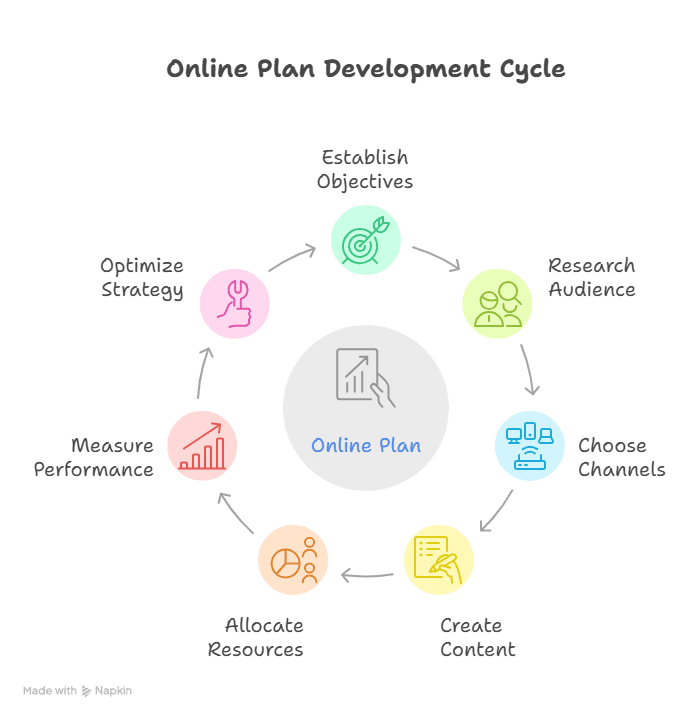A digital marketing strategy is the roadmap that guides every online effort toward clear business goals. By combining SEO, paid media, social engagement and content planning within a unified framework, you’ll avoid wasted budgets and uneven results.
Whether you’re a small start-up or an established brand, prioritising digital marketing strategy ensures consistent growth and measurable ROI.
This guide will teach you what are the best online digital marketing best practices, how to create a digital strategy and much more.
A digital marketing strategy is a master plan which:
- Sets clearly defined business goals
- Identifies target audiences and personas
- Chooses the perfect blend of digital channels
- Allocates budgets and resources
- Sets KPIs and measurement procedures
Why a Digital Marketing Strategy is Important
Without an integrated plan, your digital marketing planning is fragmented. You’ll be wasting money on ad spend that will not convert or content that will not resonate.
In fact, companies with written strategies are 538% more likely to indicate they’re successful than a firm without a strategy.¹ A solid strategy unites all the channels—SEO, email, social and PPC—into common objectives.
Source: CoSchedule, 2024
How to Develop an Online Plan
1. Establish specific objectives
Develop SMART objectives—Specific, Measurable, Achievable, Relevant and Time-bound. For instance, create to “Increase organic traffic by 30% in nine months.” Tie all goals to revenue or lead goals so the cost can be justified.
2. Research with the target audience
Use Google Analytics, social monitoring software and surveys to gather rich personas. Find the demographics, problems and online behaviours of your most valuable customers. This is a crucial step in achieving successful digital campaigns and personalised messaging.
3. Choose the ideal channels
Put each persona on its most active channels—B2B on LinkedIn, Instagram for the young customer, high-intent search ads. A comprehensive digital marketing system will tend to mix organic SEO with ad spending to achieve greatest reach.
4. Create content and creativity
Create blog articles, infographics and videos that solve actual user issues. Best practices for quality content are innate in online marketing and make your brand credible in search listings.
5. Budget and resource allocated
Prioritise channels based on estimated ROI. 60/40—60% organic behaviour, 40% paid media—a good starting point, then learn and adapt as you see the performance.
6. Measure, analyse and optimise
Monitor KPIs in real time. Use dashboards to watch metrics such as click-throughs, cost of conversion and lifetime value. Continuously optimise bids, creative, and targeting to maximise returns.

Best Practices for Digital Marketing Planning
- Personalise messaging
Personalise content dynamically to user behaviour for better engagement and conversions.
- Apply A/B testing
Test headlines, CTAs, and images to determine which ones are best performing.
- Apply mobile-first design
With more than 55% of web traffic through mobile devices, smooth mobile experience is the priority.
- Utilise automation
Apply marketing automation tools for lead nurturing, scoring, and re-engagement.
- Utilise a content calendar
Plan editorial and campaign calendars six months ahead to stay reactive to events and trends.
- Utilise user-generated content
Leapfrog authenticity and trust through review optimisation and social shares.
- Optimise for video
Video inspires 1200% more shares than images and text combined.
Source: Wordstream, 2023
Digital Marketing Framework at a Glance
| Channel | Purpose | Key Metrics | Best Practices |
| SEO | Sustainable organic traffic growth | Organic sessions, rankings | Comprehensive keyword research, on-page SEO |
| PPC | Instant visibility & conversions | CTR, CPA, ROAS | Leverage negative keywords, ad extensions |
| Social Media | Brand awareness & engagement | Impressions, engagement rate | Post frequency, UGC campaigns |
| Email Marketing | Lead retention & nurturing | Open rate, CTR, revenue | Segmentation, personalised subject lines |
| Content Marketing | Building authority & lead generation | Time on page, backlinks | Long-form guides, interactive types |
Such Valuable Insight: AI-Powered Personalisation
By 2025, 70% of marketing leaders will be investing in AI content ideation and personalisation tools.
Adding AI to your digital marketing plans means you can have highly targeted campaigns from intelligent email sequences to dynamic web experiences. Not only does this enhance efficiency but provide more relevant content at scale.
Source: Gartner, 2024
Frequently Asked Questions
1. What is digital marketing planning?
Digital marketing planning involves planning channels, content, and budget to effectively reach your target audience.
2. How do I need to update my strategy?
Review your strategy quarterly, with monthly adjustments as performance analytics to be responsive to changes in the market.
3. What are the most important KPI’s?
Use data that will align with your targets: organic traffic for SEO, the conversion rate for PPC, social engagement for social, and retention for email.
4. How do I begin on a small budget?
Prioritise low-spend, high-impact activities, such as organic SEO, content marketing, and micro-influencer collaborations.
5. What are the enablers of the digital marketing framework?
Key tools include Google Analytics, SEMrush, Mailchimp, Hootsuite and Hotjar to assist with analysis and automation.
6. How do I split organic and paid?
Start at a 60/40 organic-to-paid ratio and then allocate by what channels yield the most ROI.
7. How do I define a successful digital campaign?
Personalisation, clean CTAs, mobile optimisation and stringent A/B testing, are the key ingredients of winning digital campaigns.
8. Can I automate marketing?
Yes—applications like HubSpot and Marketo provide automated functionalities that drive leads and enhance retention.
9. How do I calculate ROI?
Compare spend to revenue across all channels using in-depth analytics dashboards.
10. Why do I need a content calendar?
A content calendar infuses consistency, aligns campaigns with significant dates and lets you maximise resource deployment.
Conclusion
A solid digital marketing plan threads discrete tactics into an integrated growth engine. By following this guide, you will:
- Align tactics and goals for maximum impact
- Optimise channels based on data insights
- Leverage AI and automation to drive maximum personalised campaigns
Ready to take your strategy to the next level? Join the MyCaptain Digital Marketing Program today, and let’s make insights happen.


